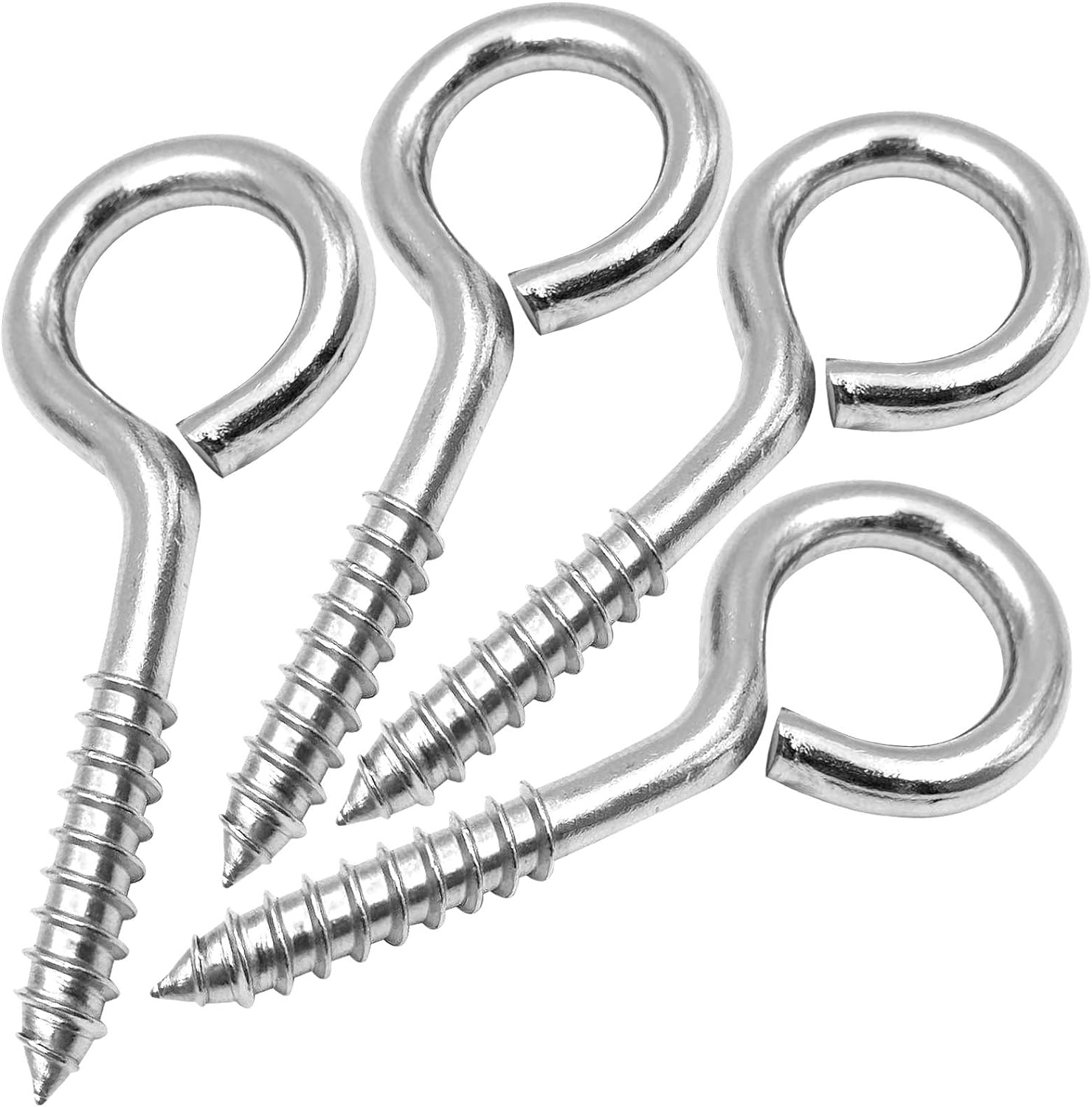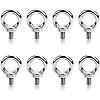Product Description
Features of Eye Screw (DIN580):
1. Certification: ISO, ROHS, SGS
2. Available Standard: DIN, ANSI, ASTM, JIS, BSW
3. Strength: Grade 4.8 or class 4.8, A2-70, A4-70, A4-80
4. Finishing: Yellow, blue, white zinc plated, Galvanized, Black Oxide
5. Available material: Carbon steel, stainelss steel SS304, A2
6. Size: M3-M24, Length: 20-300mm, Moq: 500pcs, Port: HangZhou, ZheJiang
7. Available Packing: Plastic bags+Chipboard Cartons+Plywood pallet with Belt &Film.
What you can get for the Eye Screw (DIN580):
1. Leading time: 7-15days ready for shipping for the stocked sizes
2. Samples can be free for the CHINAMFG 1
3. Certifications&MTC report can be shown togther with the samples or mass production
4. Right quality with the reasonable offer, OEM design is also acceptable.
| Mainly Product | |
| BOLT | din933, din931, din419, din558, din7990, din6922, ASME/ANSI B 18.2.1 , ASME/ANSI B 18.2.3.1M,GB, BSW, ISO Hex bolt , carriage bolt, heavy hex bolt, flange head bolt, achor bolt ect |
| Nut | din934, hex heavy hex nut, 2H nut, din555, flange bolt, cap nut, nylon nut, ect |
| Screw | hex screw, self drilling screw, self tapping screw, drywall screw, pan head screw, button head screw, machine screw, chipboard screw,furniture screw,wood screw, ect |
| Washer | flat washer, spring washer, lock washer,square washer,spring lock washer, plain washer ect |
| Thread Rod | threaded rod din976, threaded bar din975 stud bolt, B7 stud bolt ect |
| We are also professional in all the Non-Standard or Customized Items by your design! | |
| Available Material | Carbon steel,Stainless steel,Duplex Stainless steel Brass,Copper,Plastic,Aluminum |
| Surface Treatment | Zinc Plated/Galvanized,Nickel Plated,HDG,Copper Plated,Ano dized,Polishing. Powder Coating,Geomet,Dacromet,Passivation,Electrophoesis, |
| Equipments | Cold forging Machine,Thread Rolling Machine,CNC Machine,Lather Machine,Grinding Machine,Milling Machine,Drilling Machine,Casting Machine |
| Processing Way | Cold Forging,Stamping,Rolling,Bending,Casting,Extrusion,Milling,Welding,Turning |
| Processing drawing Format |
. jpg /. pdf / . dwg / . igs / . stp etc. |
| Trade Term | EXW, FOB, CIF, DDP, CFR,or as discussing |
| Payment Term | T/T,L/C,Western Uion |
| Packagement | Plastic Bag+Chipboard Carton +Plywood Pallet With Belt and Film |
/* January 22, 2571 19:08:37 */!function(){function s(e,r){var a,o={};try{e&&e.split(“,”).forEach(function(e,t){e&&(a=e.match(/(.*?):(.*)$/))&&1
| Material: | Carbon Steel |
|---|---|
| Type: | Round Head |
| Connection: | Common Bolt |
| Head Style: | Round |
| Standard: | DIN, GB, ANSI, BSW, JIS, GOST |
| Grade: | 4.8 |
| Customization: |
Available
|
|
|---|

How does the choice of eye bolt screws impact the overall safety and reliability of installations?
The choice of eye bolt screws plays a crucial role in ensuring the overall safety and reliability of installations. Selecting the appropriate eye bolt screws based on factors such as load requirements, environmental conditions, and material compatibility is essential to prevent failures, maintain structural integrity, and ensure the safety of personnel. Here’s a detailed explanation of how the choice of eye bolt screws impacts the overall safety and reliability of installations:
- Load Capacity: Eye bolt screws are designed to bear specific loads, and choosing screws with an appropriate load capacity is paramount. Using eye bolt screws with insufficient load capacity can lead to overloading, deformation, or failure, jeopardizing the safety and reliability of the installation. It is crucial to consider the expected loads and select eye bolt screws that can handle them safely.
- Material Strength: Eye bolt screws are available in various materials, including stainless steel, carbon steel, and alloy steel. The choice of material should be based on the application’s requirements, considering factors such as strength, corrosion resistance, temperature resistance, and compatibility with other components. Selecting eye bolt screws made from the appropriate material ensures durability and long-term reliability of the installation.
- Thread Type and Size: Eye bolt screws come in different thread types and sizes. Choosing the correct thread type (such as UNC, UNF, or metric) and size ensures proper engagement and secure fastening. Mismatched or incompatible threads can result in weak connections, reduced load capacity, or thread damage, compromising the safety and reliability of the installation.
- Environmental Considerations: Consider the environmental conditions in which the eye bolt screws will be used. Factors such as exposure to moisture, chemicals, high temperatures, or extreme weather conditions can affect the performance and longevity of the screws. Selecting eye bolt screws with appropriate coatings, materials, or corrosion-resistant properties ensures their reliability and prevents premature failure due to environmental factors.
- Installation Method: The choice of eye bolt screws can also impact the installation method and techniques. Some eye bolt screws may require specific installation procedures, such as torque specifications or specific tools. Following the recommended installation practices ensures proper engagement, load distribution, and overall safety of the installation.
- Compliance with Standards: Eye bolt screws should meet relevant industry standards, guidelines, or regulations. Choosing screws that comply with recognized standards ensures that they have undergone rigorous testing, meet specific quality requirements, and are suitable for the intended application. Compliance with standards enhances the safety and reliability of the installation.
By carefully considering these factors and selecting the appropriate eye bolt screws, the overall safety and reliability of installations can be significantly enhanced. It is advisable to consult with manufacturers, engineers, or professionals experienced in the field to ensure the correct choice of eye bolt screws for specific applications. Regular inspections, maintenance, and adherence to safety protocols further contribute to maintaining the safety and reliability of installations over time.

What safety guidelines should be followed when using eye bolt screws in lifting applications?
When using eye bolt screws in lifting applications, it is crucial to follow specific safety guidelines to ensure the safety of personnel, prevent accidents, and maintain the integrity of the lifting operation. Here are some important safety guidelines to consider:
- Proper Selection: Choose eye bolt screws that are appropriate for the intended lifting application. Consider factors such as load capacity, material strength, corrosion resistance, and compliance with relevant standards to ensure the selected eye bolt screws can safely handle the expected loads and environmental conditions.
- Inspect Regularly: Regularly inspect eye bolt screws for any signs of damage, wear, or deformation. Inspections should be carried out before each use and periodically during the service life of the eye bolt screws. If any defects or issues are identified, the eye bolt screws should be replaced or repaired before further use.
- Proper Installation: Follow the manufacturer’s instructions for the proper installation of eye bolt screws. Ensure that the eye bolt screws are securely and correctly installed in a compatible structure or support system. Pay attention to the recommended torque values and installation techniques to achieve proper engagement and load distribution.
- Load Calculation: Determine the load requirements and calculate the appropriate load capacity for the eye bolt screws. Avoid overloading the eye bolt screws beyond their rated capacity, as this can lead to failure and unsafe lifting conditions. Consider dynamic loads, shock loads, and any other relevant factors in the load calculation.
- Use Proper Hardware: Select and use appropriate hardware, such as shackles, hooks, or connectors, that are compatible with the eye bolt screws and the lifting equipment being used. Make sure the hardware is in good condition, properly rated for the loads involved, and securely attached to the eye bolt screws.
- Avoid Side Loading: Eye bolt screws should be used in a manner that avoids side loading. Side loading, which occurs when the load is applied at an angle to the axis of the eye bolt screw, can significantly reduce its load capacity and lead to failure. Ensure that the load is applied in line with the axis of the eye bolt screws.
- Regular Maintenance: Implement a routine maintenance program to ensure the ongoing safety and reliability of the eye bolt screws. This may include lubrication, cleaning, and periodic inspections to identify any signs of wear, corrosion, or other issues that could compromise the integrity of the eye bolt screws.
- Training and Awareness: Provide proper training and awareness to personnel involved in the lifting operation. Ensure that they understand the safe and proper use of eye bolt screws, including the importance of load limits, inspection procedures, and adherence to safety guidelines. Promote a culture of safety and encourage reporting of any concerns or incidents.
- Compliance with Standards: Familiarize yourself with relevant industry standards, regulations, and guidelines pertaining to lifting operations and eye bolt screws. Ensure that the selected eye bolt screws and the lifting operation comply with these standards to maintain safety and legal compliance.
By following these safety guidelines, you can minimize the risk of accidents, prevent equipment failures, and ensure the safe and efficient use of eye bolt screws in lifting applications.

Can you describe the proper installation and use of eye bolt screws in different settings?
Proper installation and use of eye bolt screws are essential to ensure their effectiveness, safety, and longevity in various settings. Here are general guidelines for the installation and use of eye bolt screws in different settings:
- Preparation:
- Identify the specific application and determine the load requirements, environmental conditions, and any applicable regulations or standards.
- Select an appropriate eye bolt screw considering factors such as load capacity, material strength, corrosion resistance, and compatibility with the intended application.
- Inspect the eye bolt screw for any defects, damage, or signs of wear before installation. Do not use a damaged or compromised eye bolt screw.
- Installation:
- Pre-drill a hole or use a threaded receptacle of the appropriate size and depth to accommodate the eye bolt screw.
- Screw the threaded end of the eye bolt screw into the pre-drilled hole or threaded receptacle. Ensure that the threads engage smoothly and do not cross-thread.
- Tighten the eye bolt screw using an appropriate tool, such as a wrench or socket. Avoid over-tightening, as it may cause damage to the threads or the attachment point.
- If the eye bolt screw has a shoulder or collar, ensure that it rests securely against the attachment surface for optimal load distribution.
- Load Application:
- Attach the appropriate hardware, such as ropes, cables, or chains, to the eye of the eye bolt screw. Ensure that the hardware is compatible with the size and shape of the eye.
- Inspect the attachment to verify that the hardware is properly secured within the eye and does not show signs of slippage or deformation.
- Apply the load gradually and avoid sudden impacts or jerks that could cause excessive stress on the eye bolt screw or the attachment point.
- Regularly inspect the eye bolt screw and the attachment for signs of wear, deformation, or loosening. If any issues are identified, take appropriate action to address them, such as tightening the eye bolt screw or replacing it if necessary.
- Maintenance and Safety:
- Regularly inspect the eye bolt screw and its attachment for corrosion, wear, or damage. Clean and lubricate the eye bolt screw as needed, following the manufacturer’s recommendations.
- Follow any specific maintenance instructions provided by the manufacturer for the particular type of eye bolt screw and its corresponding application.
- Ensure that the load applied to the eye bolt screw does not exceed its rated capacity. Refer to load charts or consult with engineers or professionals when dealing with higher loads or critical applications.
- Adhere to relevant safety guidelines and regulations specific to the industry or setting in which the eye bolt screw is being used.
It is important to note that these guidelines provide general information for the installation and use of eye bolt screws. However, specific installations may have unique requirements or considerations based on the application and industry standards. Therefore, it is recommended to consult with professionals or experts in the relevant field to ensure proper installation and use of eye bolt screws in specific settings.


editor by Dream 2024-05-06